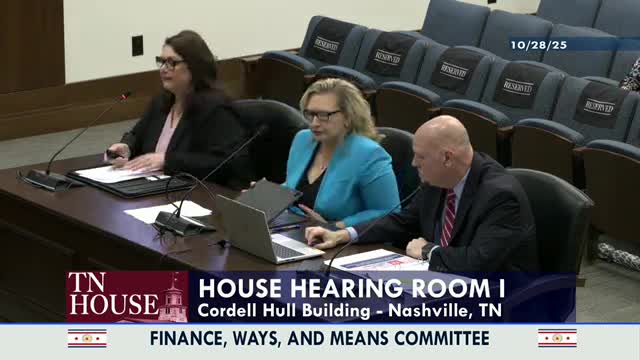Office of Criminal Justice Programs details grants for law enforcement, victim services and violent‑crime intervention funding
October 28, 2025 | Finance, Ways, and Means, House of Representatives, Committees, Legislative, Tennessee
This article was created by AI summarizing key points discussed. AI makes mistakes, so for full details and context, please refer to the video of the full meeting. Please report any errors so we can fix them. Report an error »

Jennifer Brinkman, director of the Office of Criminal Justice Programs, told the House Finance, Ways and Means Committee that OCJP has used state and federal grants to support local law enforcement, campus safety, jail programming and victim services.
Key points from the OCJP briefing
- Violent crime and law enforcement grants: OCJP used federal and state funds to buy equipment (P25 radios, digital forensics equipment) and to target support to law enforcement agencies serving ZIP codes with high homicide rates and downtown public safety enhancements.
- Campus safety: A 2024 appropriation of $30 million targeted safety upgrades (physical security assessments, hardened doors, dispatch/monitoring upgrades) across almost 40 public and private institutions of higher education.
- Jail programming and reentry support: The department said $10.5 million supported evidence‑based programming for local jails under the Reentry Success Act; 28 county jails received vocational and reentry programming this fiscal year.
- Victim services and VOCA: Federal VOCA awards vary; the state received about $9 million in earlier years and as much as $68 million in 2018. This year's federal award was roughly $26 million, and the legislature appropriated nonrecurring supplements ($13 million for FY25 and $20 million planned) to prevent drastic reductions for provider networks.
Questions about administrative cost rates and retained percentages
- Several lawmakers asked why OCJP's retained administrative percentage appeared higher than the 5 percent many programs use. Brinkman and OCJP staff said the office initially retained 10 percent consistent with federal criminal justice grant allowances, to fund staffing and program administration. OCJP reported it is reallocating funds not needed for administration and expects the effective administrative draw on certain programs to be lower (1–3 percent for the Violent Crime Intervention Fund in subsequent distributions).
Ending note: OCJP said it will continue working with local partners and STS on grants management and that the office is adapting retained percentages based on actual administrative needs and federal allowances.
Key points from the OCJP briefing
- Violent crime and law enforcement grants: OCJP used federal and state funds to buy equipment (P25 radios, digital forensics equipment) and to target support to law enforcement agencies serving ZIP codes with high homicide rates and downtown public safety enhancements.
- Campus safety: A 2024 appropriation of $30 million targeted safety upgrades (physical security assessments, hardened doors, dispatch/monitoring upgrades) across almost 40 public and private institutions of higher education.
- Jail programming and reentry support: The department said $10.5 million supported evidence‑based programming for local jails under the Reentry Success Act; 28 county jails received vocational and reentry programming this fiscal year.
- Victim services and VOCA: Federal VOCA awards vary; the state received about $9 million in earlier years and as much as $68 million in 2018. This year's federal award was roughly $26 million, and the legislature appropriated nonrecurring supplements ($13 million for FY25 and $20 million planned) to prevent drastic reductions for provider networks.
Questions about administrative cost rates and retained percentages
- Several lawmakers asked why OCJP's retained administrative percentage appeared higher than the 5 percent many programs use. Brinkman and OCJP staff said the office initially retained 10 percent consistent with federal criminal justice grant allowances, to fund staffing and program administration. OCJP reported it is reallocating funds not needed for administration and expects the effective administrative draw on certain programs to be lower (1–3 percent for the Violent Crime Intervention Fund in subsequent distributions).
Ending note: OCJP said it will continue working with local partners and STS on grants management and that the office is adapting retained percentages based on actual administrative needs and federal allowances.
Don't Miss a Word: See the Full Meeting!
Go beyond summaries. Unlock every video, transcript, and key insight with a Founder Membership.
✓
Get instant access to full meeting videos
✓
Search and clip any phrase from complete transcripts
✓
Receive AI-powered summaries & custom alerts
✓
Enjoy lifetime, unrestricted access to government data
30-day money-back guarantee

